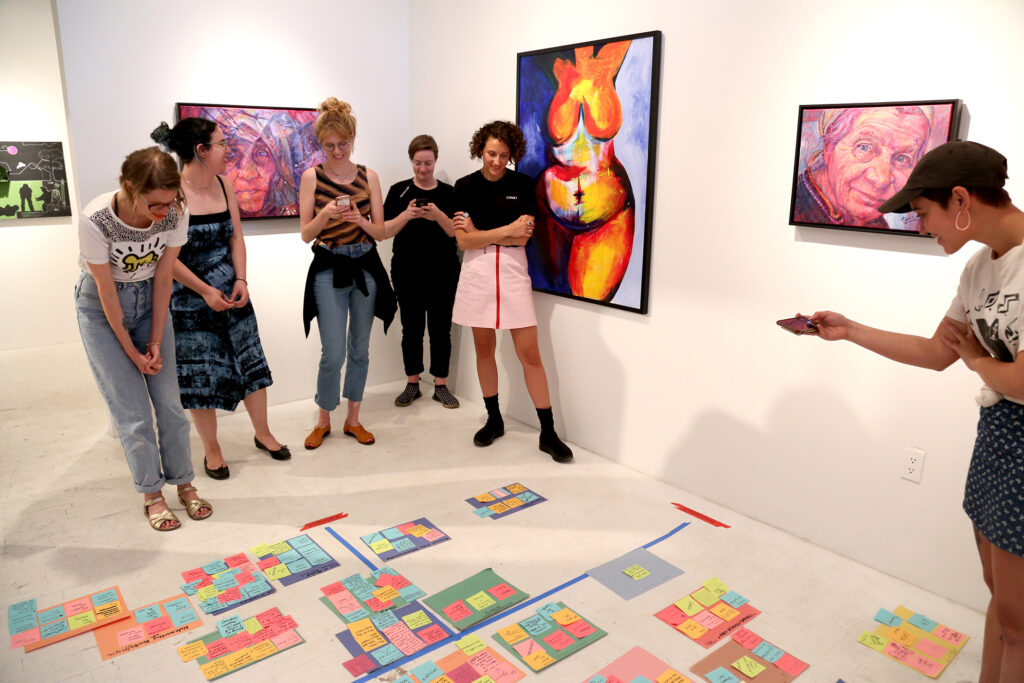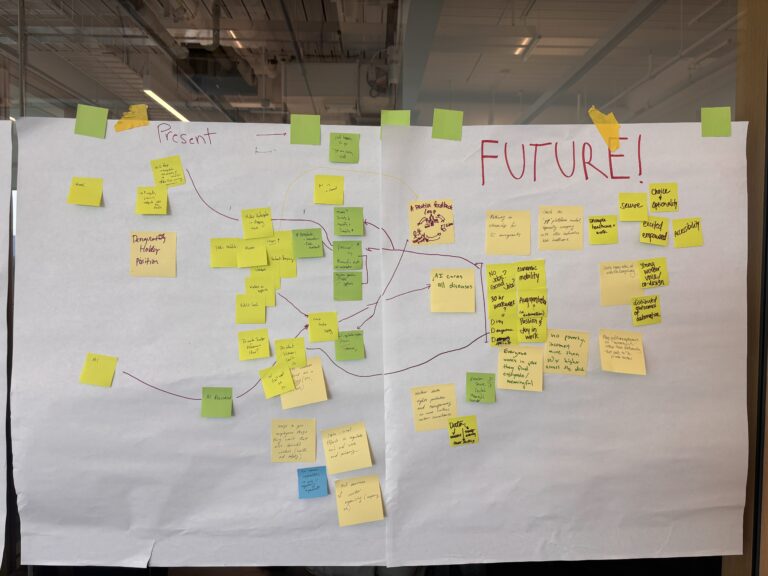
“Sorting Feminist Data collected at SOHO20, July 2018“
What is Creative Research?
What is the role of art and creative expression in better understanding and shaping the impact of technology on society? We explored this question in conversation with artists, technologists, and researchers engaged in creative practice. The perspectives below reflect some of what we’re heard as viewed through our own lens as a research and philanthropic organization. What we found was a complex and rich ecosystem that eludes easy definition.
Our interest in the intersections of art and technology is deeply rooted in a curiosity about the ways that creative practices can illuminate and interrogate the intersections of our social and technological worlds. As an organization committed to an inquiry-based approach, research is central to any foray into art and creativity. We define “creative research” simply as research with creative outputs. We believe such outputs might complement or even replace traditional publication, such as immersive experiences that bring esoteric concepts like “data justice” or “extractivism” into the tangible realm, or design prototypes like atlases for complex infrastructures or open-source workbooks that center often-overlooked communities or users.
Much of our research strategy and funding to date has centered on social science research with outputs that fit more squarely in academic outlets (i.e. peer-reviewed journal articles and scholarly analysis) and policy realms (i.e. white papers, policy briefs). But as technology and its impact on society continue to deliver thorny questions, we recognize the need to meet this moment with an openness to new possibilities. Creative research challenges and resists the dominance of traditional knowledge by widening the aperture of “research” to include different perspectives, ideas, and ways of knowing.
The Power of Creative Research
Artists include makers, writers, designers, and creators most generally. Art makes big ideas tangible in order to better understand the world. It has the power to communicate to the public and the power to translate across disciplines.
But artistic thinking is not just for artists. It is a skill set that anyone can cultivate. We also acknowledge that “art” can be an opaque term that conjures antiquated debates about what “counts” as art and who can claim the title of “artist.” This is not a conversation that we are very interested in continuing. Instead, we want to explore how creativity and art – broadly defined – can enable the power of imagination, extend the current conception of the possible, and bring distinct viewpoints into conversations where they may otherwise not be heard.
As it relates to our research strategy, creative research has the power to explore without the typical confines of research with predetermined goals. Creative research can refocus our lenses in unexpected ways, revealing insights that the public may not see. This “public” includes researchers, policymakers, and technologists who approach technology through a specific set of questions. Because inquiry is at the heart of our practice, raising new sets of questions is itself a useful outcome.
Today, interaction and interconnections between research, activism, and policy are difficult to foster and sustain due to different language/jargon, incentive structures, and perspectives. When brought together with creative practices, we believe disciplinary silos can be more easily broken down. Creative practices have the power to gather unlikely actors to the same table, spark meaningful conversation, and enable the imagining of new possibilities for our future. Creative practices point us to the future and enable speculation about what is possible beyond what we normally see.
Creative Research in Practice
Creative research can successfully engage the public in important conversations about technology. For example, Mimi Onuoha’s Library of Missing Datasets contained empty folders representing information nobody is collecting, such as research into violence from guns or Black maternity deaths, asking us to question what data we care enough to collect and what data goes missing despite its importance to public health and safety. The piece is a result of a research process, one focused not on gathering data but on gathering questions and evidence of absences. By definition, this research is a powerful shift in perspective, articulated in a powerful manner. Bringing the public to acknowledge otherwise difficult to express ideas is one relationship between creative research and its outcomes.
Creative research can also partner with more traditional research to help educate on the complexity of opaque infrastructures. With their work, Anatomy of an AI System, Kate Crawford and Vladan Joler make visible the intricate and interdependent nature of AI systems like Amazon Alexa. The map raises questions around the way we define artificial intelligence, and extends our understanding of the larger system and its entangled complexities. For example, the work includes pay rates of miners extracting precious metals to build these systems, as well as the cost of running the cloud servers and marketing. Again, the work has a substantial research component as it collects and links information about these pieces of the system. But in bringing them to a creative output, it also suggests new ways of imagining and defining AI systems, making tangible their broader reach – and clarifying the need to include many more touch points into our definitions of AI. Creative research projects have the power to make complex systems more understandable, showing us different lenses from which to ask important questions.
While creative research can raise important questions in accessible ways, it can also contribute unique approaches. Just as traditional research emphasizes thinking-through problems, creative research offers a way of “making-through” problems: applying the skills of a designer, for example, to new ways of prototyping or evaluating systems that aren’t oriented toward market share, but social values. Caroline Sinders’ Feminist Data Set, for example, went into real communities to re-imagine data pipelines, simultaneously educating and empowering these communities, engaging them to think about how they might design it differently. The result was a number of concepts and guiding principles that aimed to design these systems in ways that were more inclusive. Such work re-frames the decisions that go into a machine learning system from an intersectional lens, pointing to clearer goals for communities and designers alike.
Creative Research is Research
Finding funding opportunities for creative research can be difficult beyond the limitations in language and labels discussed above. In our conversations with creative researchers, we found they faced three main pain points in their search for funding support: (1) a divide between artists and researchers; (2) the time that creative research requires; and (3) the requirement to measure impact according to more traditional metrics of academic research.
First, unnecessary divisions between artists and researchers hinders the generative work that can happen through creative research. It leaves creative researchers feeling excluded from opportunities as they are considered “too artistic” for research opportunities or else “too research-focused” for artistic opportunities. This is often the result of artists’ work being limited to insular artist residency programs, and research fellowships being closed to creative researchers. Framing this work as creative research – rather than the catch-all term of “art” – has helped keep us cognizant of the mutually beneficial relationship between traditional and creative researchers. We recognize creative making is a legitimate output of research.
Another pain point for creative researchers is time. Like more traditional researchers, creative researchers engage in rigorous processes that take time and resources. The findings of this research are then translated into, or through the production of, a creative output. Creative outputs may supplant, but more often augment, written outputs like reports, essays, and articles. More time is something many researchers, traditional and creative alike, could always use. Many of the creative researchers we spoke with cited time as a particular precarity in available funding opportunities and noted that this work may take more time than traditional research and yet is often allotted less. Part of this pain point is a lack of access to larger grant-making entities, such as the National Science Foundation and other federal grants which embrace many questions, but often focus on specific approaches.
The third major pain point for funding creative research is the paradigmatic shift necessary to measuring the success of creative research. While creative research can be as rigorous as traditional research, the outputs are not the same – and indeed, every project may require a distinct tool for measuring impacts. Measuring the impact of creative research, like measuring the impact of traditional research, poses challenges since commonly used indicators such as conference awards or citations are several degrees removed from gauging actual impact (indeed, there is also space to question the efficacy of these commonly used indicators as proxies for real world impact). As it relates to reporting back to grant-making organizations, there is a need to balance requirements that are helpful to the mission with flexibility for creative processes. We also acknowledge that the ecosystem of support for creative research often struggles with similar issues.
Our Goals for Integrating Creative Research into Our Portfolio
Funding creative researchers can help point us to new questions and new methods for finding and collaborating on solutions. Creative research can help move us beyond a specific way of arriving at answers, and think outside institutionalized forms of knowledge. Making, design, and collaboration can create new ways of engaging communities.
In the coming years, we hope to source creative research projects, ideas, and/or methods that are consistent with our research approach and priorities. We also aim to work with our existing research partners and grantees to see where creative research approaches might be relevant for their own project and agendas. Stay tuned for updates on future creative research projects, researchers, and reflections as they emerge.
This introduction was written by Madison Snider, Research Associate at Siegel Family Endowment, and Eryk Salvaggio, Research Communications Consultant.





